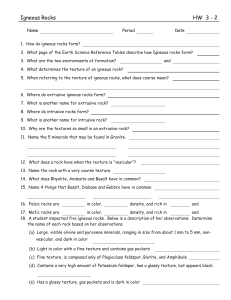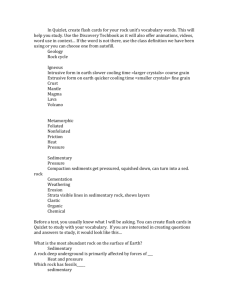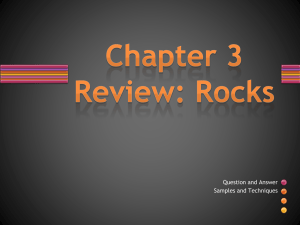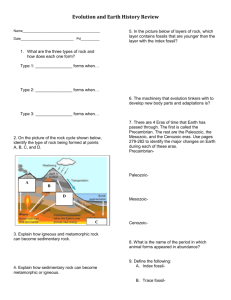Sample A
advertisement
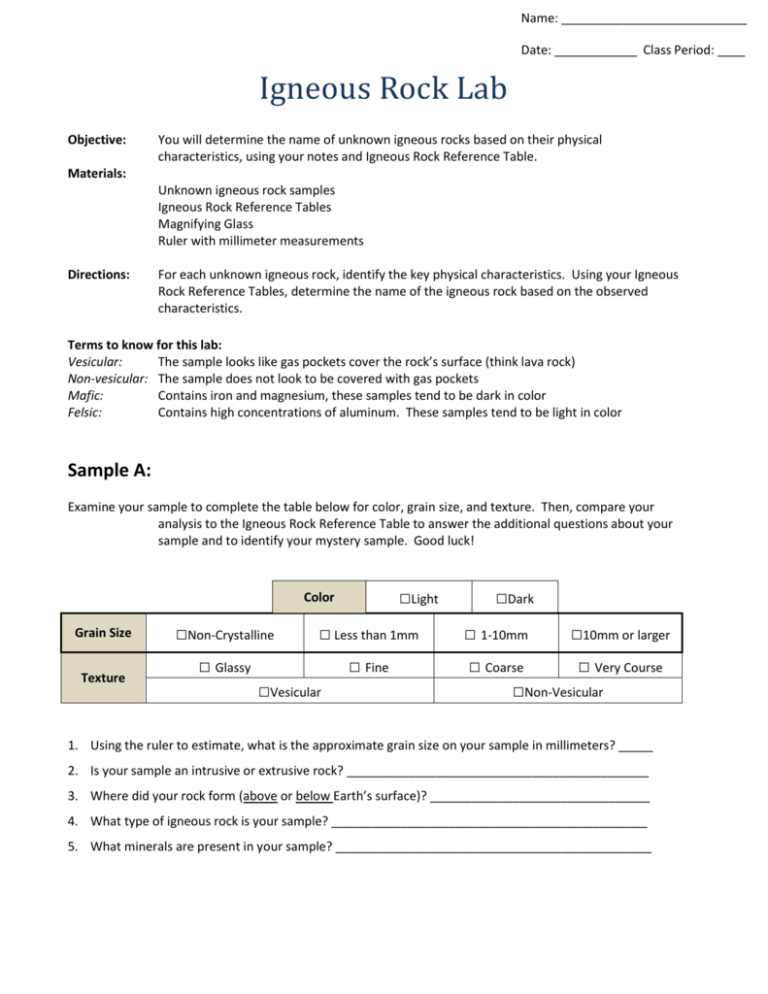
Name: ___________________________ Date: ____________ Class Period: ____ Igneous Rock Lab Objective: You will determine the name of unknown igneous rocks based on their physical characteristics, using your notes and Igneous Rock Reference Table. Materials: Unknown igneous rock samples Igneous Rock Reference Tables Magnifying Glass Ruler with millimeter measurements Directions: For each unknown igneous rock, identify the key physical characteristics. Using your Igneous Rock Reference Tables, determine the name of the igneous rock based on the observed characteristics. Terms to know for this lab: Vesicular: The sample looks like gas pockets cover the rock’s surface (think lava rock) Non-vesicular: The sample does not look to be covered with gas pockets Mafic: Contains iron and magnesium, these samples tend to be dark in color Felsic: Contains high concentrations of aluminum. These samples tend to be light in color Sample A: Examine your sample to complete the table below for color, grain size, and texture. Then, compare your analysis to the Igneous Rock Reference Table to answer the additional questions about your sample and to identify your mystery sample. Good luck! □Light Color Grain Size Texture □Non-Crystalline □ Less than 1mm □ Glassy □ Fine □Vesicular □Dark □ 1-10mm □10mm or larger □ Coarse □ Very Course □Non-Vesicular 1. Using the ruler to estimate, what is the approximate grain size on your sample in millimeters? _____ 2. Is your sample an intrusive or extrusive rock? ____________________________________________ 3. Where did your rock form (above or below Earth’s surface)? ________________________________ 4. What type of igneous rock is your sample? ______________________________________________ 5. What minerals are present in your sample? ______________________________________________ Sample B: Examine your sample to complete the table below for color, grain size, and texture. Then, compare your analysis to the Igneous Rock Reference Table to answer the additional questions about your sample and to identify your mystery sample. Good luck! □Light Color Grain Size Texture □Non-Crystalline □ Less than 1mm □ Glassy □ Fine □Dark □ 1-10mm □10mm or larger □ Coarse □ Very Course □Non-Vesicular □Vesicular 6. Using the ruler to estimate, what is the approximate grain size on your sample in millimeters? _____ 7. Is your sample an intrusive or extrusive rock? ____________________________________________ 8. Where did your rock form (above or below Earth’s surface)? ________________________________ 9. What type of igneous rock is your sample? ______________________________________________ What minerals are present in your sample? _________________________________________________ Sample C: Examine your sample to complete the table below for color, grain size, and texture. Then, compare your analysis to the Igneous Rock Reference Table to answer the additional questions about your sample and to identify your mystery sample. Good luck! □Light Color Grain Size Texture □Non-Crystalline □ Less than 1mm □ Glassy □ Fine □Vesicular □Dark □ 1-10mm □10mm or larger □ Coarse □ Very Course □Non-Vesicular 10. Using the ruler to estimate, what is the approximate grain size on your sample in millimeters? _____ 11. Is your sample an intrusive or extrusive rock? ____________________________________________ 12. Where did your rock form (above or below Earth’s surface)? ________________________________ 13. What type of igneous rock is your sample? ______________________________________________ What minerals are present in your sample? _________________________________________________



